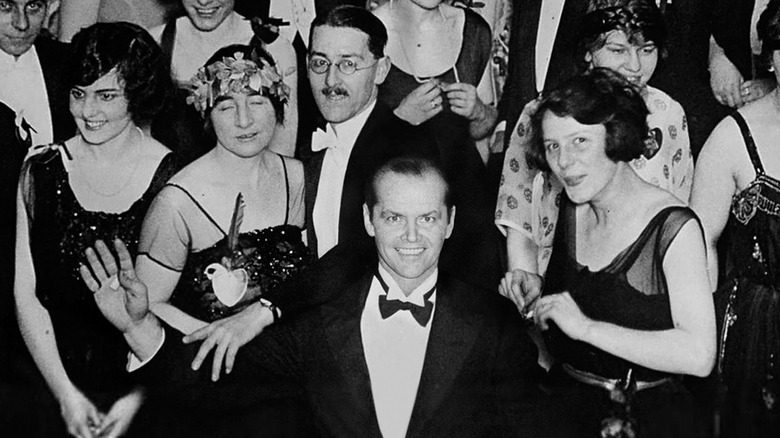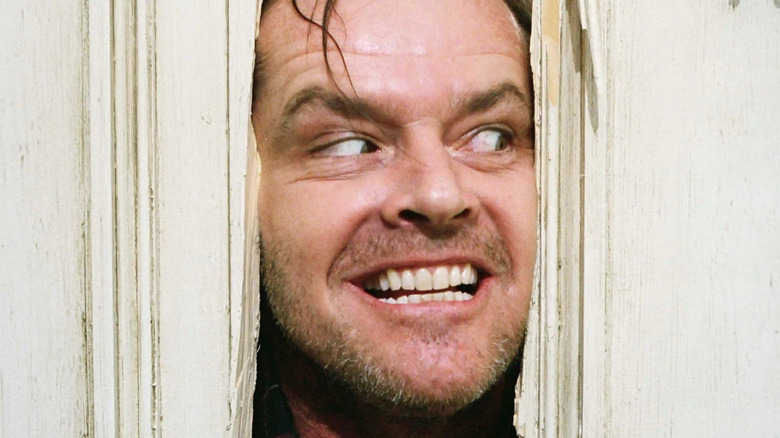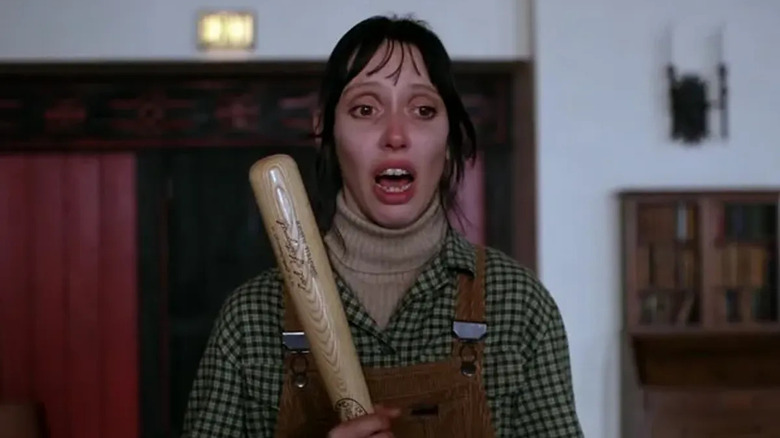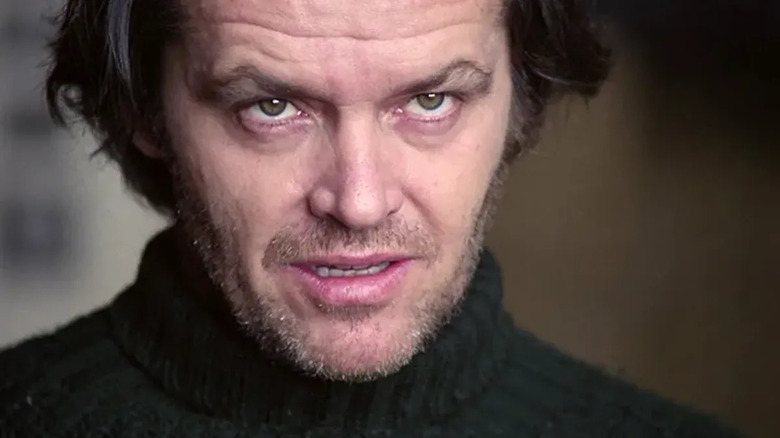The Shining's Famous July 4th Photo Wasn't Exactly Simple To Shoot
Stanley Kubrick's "The Shining" is a head trip and a half. As its main character, Jack Torrance, goes madder and madder over the course of a winter stay as a hotel caretaker, the film ratchets up its surrealism and horror, turning the hotel itself into an almost Lovecraftian, unknowable terror.
The movie doubles down on that troubling trajectory all the way to the very last frames, where the audience sees present-day Torrance (Jack Nicholson) posing with a large group of hotel patrons for a lavish Fourth of July ball in the year 1921. Obviously, it's an impossible moment that defies true explanation, and the not knowing is what makes it all the more unsettling. In order to achieve this, the filmmaker revealed in an interview with Michel Ciment that he went a completely unconventional route and didn't end up using extras. He said:
"No, they were in a photograph taken in 1921 which we found in a picture library. I originally planned to use extras, but it proved impossible to make them look as good as the people in the photograph. So I very carefully photographed Jack, matching the angle and the lighting of the 1921 photograph, and shooting him from different distances too, so that his face would be larger and smaller on the negative. This allowed the choice of an image size which when enlarged would match the grain structure in the original photograph. The photograph of Jack's face was then airbrushed into the main photograph, and I think the result looked perfect. Every face around Jack is an archetype of the period."
Kubrick's method and its effectiveness
The authenticity of the photograph isn't necessarily a make-or-break detail when you're immersed in the film, but knowing the legitimacy of the faces surrounding Jack makes his inclusion all the more haunting. It heightens an already eerie and uncomfortable moment and turns it into a deeply troubling realization, the kind that makes Lovecraftian creatures so terrifying. The realization here is that there is some unknowable reason that Jack is able to have been present in the now and also front and center in this image — and we may never understand why — only that it is an unwaverable truth.
We've been prepped for this moment throughout the film, specifically when Grady, the hotel's former caretaker, appears to Torrance when he is exploring the hotel, but that doesn't make it any less disturbing when we realize Torrance is just like Grady, even if we don't know how he became that way. Was he always destined for this fate, way before he ever met anyone related to the Overlook Hotel? Again, the not knowing is what brings the terror in this scenario, and the incredible July 4th image is a testament to how long that horror lingers after the final frame.
The Shining's approval rating
Despite its permanent place in the horror canon and the zeitgeist as a whole, King had very little love for Kubrick's adaptation of his novel. In a previous interview with Deadline, the author explained his issues with the characters, especially Jack and Wendy, and the film's emotional core — or lack thereof.
He said, "The character of Jack Torrance has no arc in that movie ...absolutely no arc at all. When we first see Jack Nicholson, he's in the office of Mr. Ullman, the manager of the hotel, and you know, then, he's crazy as a s—t house rat. All he does is get crazier. In the book, he's a guy who's struggling with his sanity and finally loses it. To me, that's a tragedy. In the movie, there's no tragedy because there's no real change."
He also noted that he felt Shelly Duvall's version of Torrance's wife was "one of the most misogynistic characters ever put on film" because she is "basically just there to scream and be stupid." King added, "That's not the woman that I wrote about."
Books versus movies
Part of the problem here lies in the fact that books are always going to be longer than films. So much of Jack and Wendy's character development has to be simplified from the labyrinth that is present in the book in order to fit it into a two-hour experience. Was Wendy's story and broad emotional life truncated in order to give the spotlight to Jack and his downfall? Yes, but that was where Kubrick found the film's deepest horror.
After all, Wendy is a victim of his, and I would even argue that her screaming "stupidity," which usually presents itself in the form of hysterical tears in response to her husband changing in front of her eyes, is crucial for us to see Jack in the way we need to for Kubrick's film to work. Duvall's portrayal is in service of Jack's greater undoing the way Kubrick wanted to frame it. King's distaste for her performance simply doubles down on his distaste for Kubrick's interpretation, nothing more. To be completely fair, saying her performance had no nuance also diminishes the impact that Kubrick had upon Duvall while shooting the film — and that deserves a whole separate conversation in and of itself.
King went on to say in 2016, "I think 'The Shining' is a beautiful film and it looks terrific and as I've said before, it's like a big, beautiful Cadillac with no engine inside it." But there's no denying that the abject terror that the film has injected into us for decades is a result of the complete opposite type of film. Yes, it's beautiful and is dripping in the pleasing Kubrick aesthetic, but there's a lot more under the surface in both the production and performances alike.



